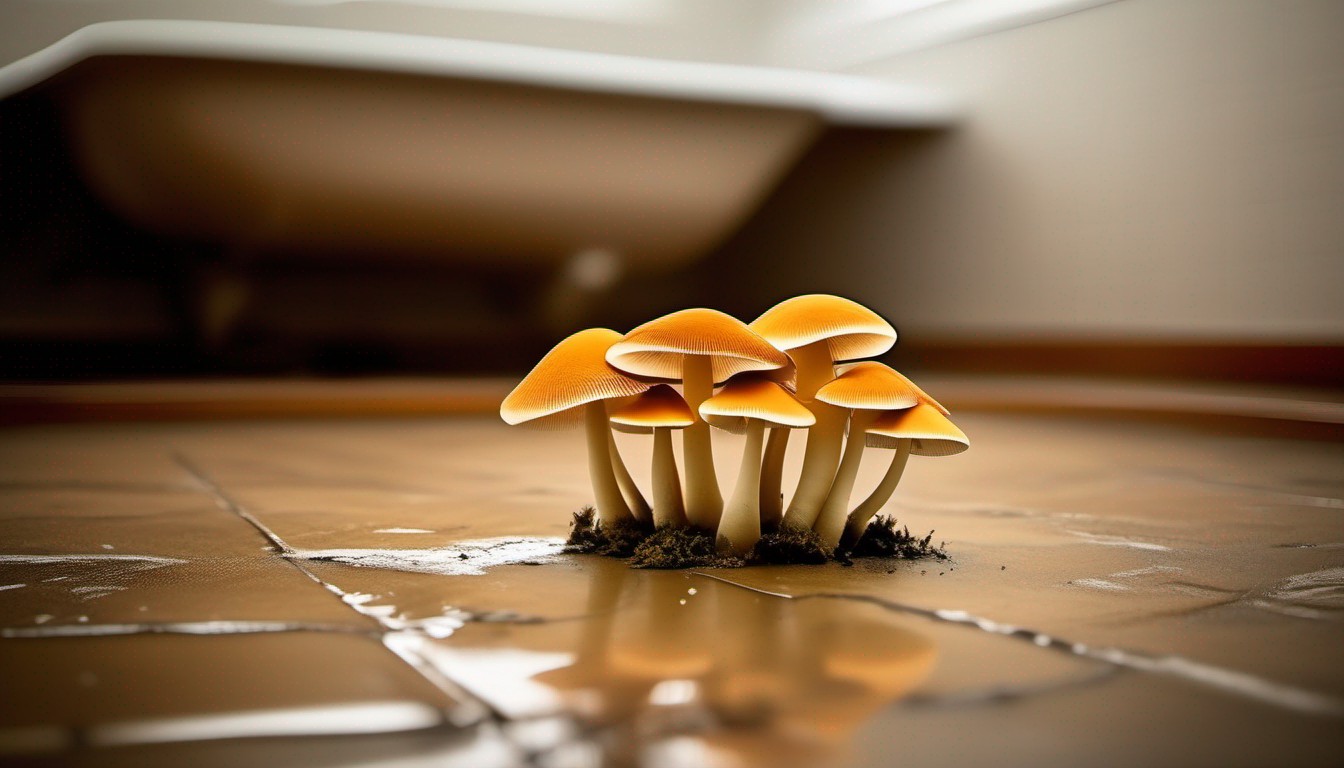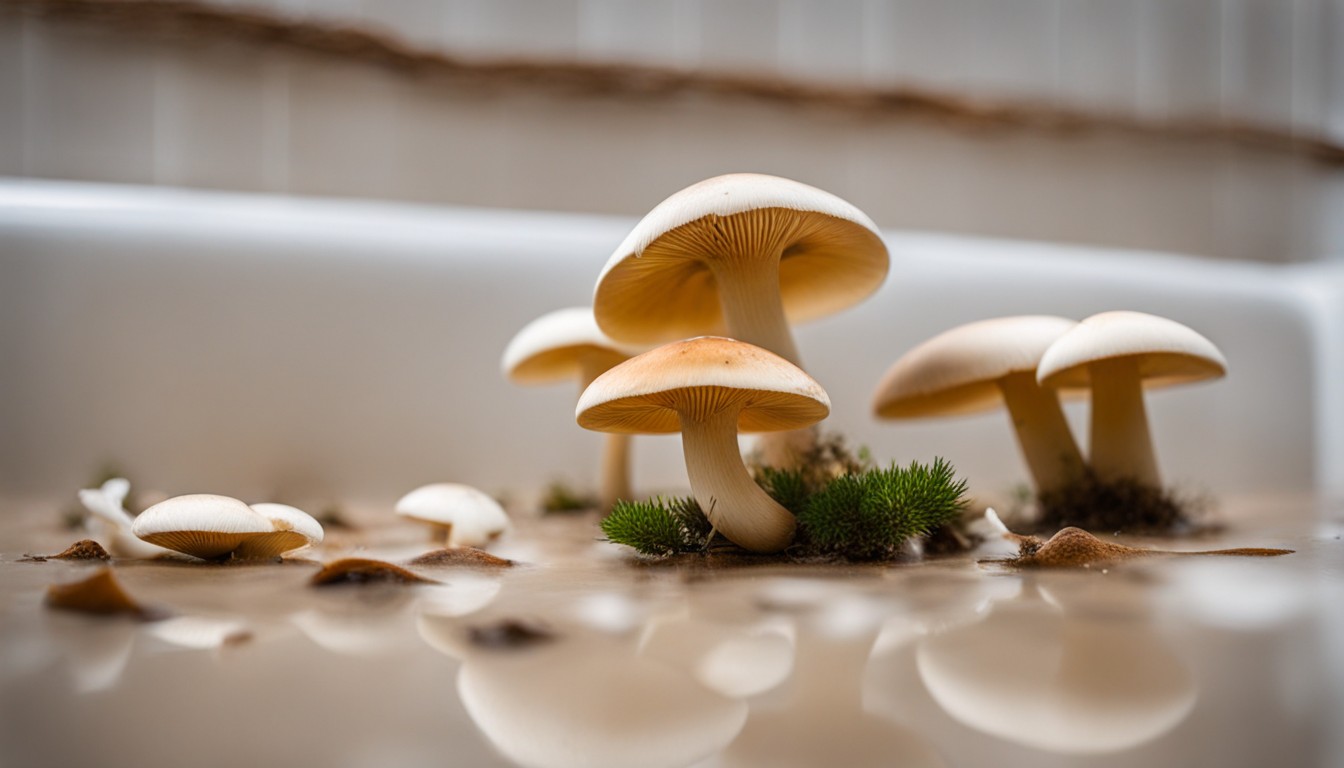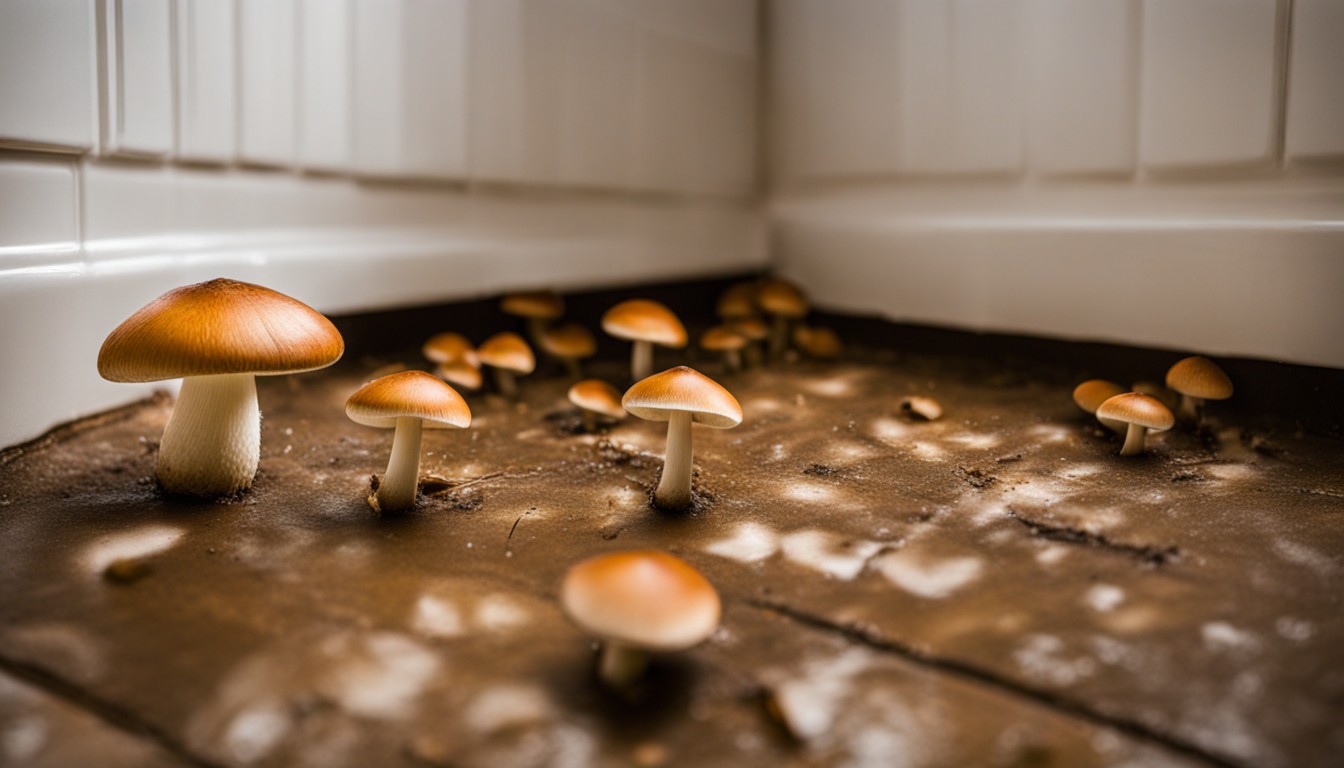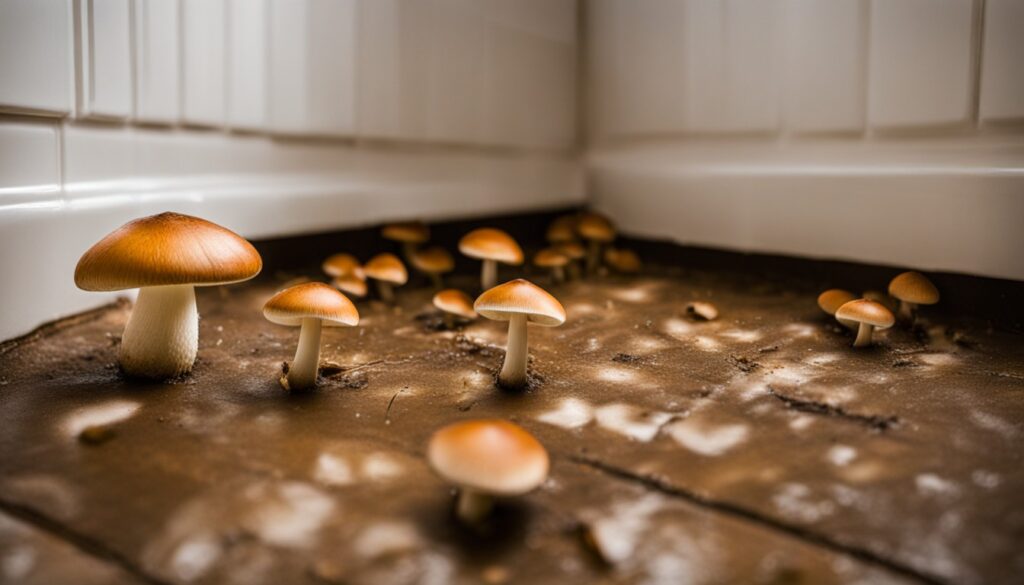Mushrooms growing in the bathroom floor can be a common yet frustrating problem for homeowners. In this blog post, we will explore the causes behind this issue and provide effective solutions to prevent mushroom growth in your bathroom. Understanding the factors contributing to the growth of mushrooms, such as moisture and organic matter, is crucial in tackling this problem. By implementing preventive measures and taking prompt action, you can maintain a clean and hygienic bathroom environment. Follow our expert tips and recommendations to eliminate mushrooms from your bathroom floor and prevent their recurrence in the future.
Understanding the Mushroom Growth in Bathroom Floors
Mushroom growth on bathroom floors reveals an underlying problem with moisture and humidity, key catalysts that nourish fungi under certain conditions. It’s crucial to recognize these signals, to pinpoint the source of the problem and employ effective solutions.
Finding mushrooms sprouting from your bathroom floor can be disconcerting, but it is nothing more than a clear sign pointing to moisture issues. Properly investigating and understanding the risks, complexities, and pervasiveness of this problem can enable timely, efficient, and successful remediation.
What causes mushrooms to grow in bathroom floors?
An array of factors can trigger the growth of mushrooms in bathroom floors. Excessive humidity, poor ventilation, and plumbing leaks are all capable of creating favorable conditions for these fungi to thrive.
A combination of excess humidity, poor ventilation, and plumbing leaks fosters ideal conditions for spore-based growth of mushrooms on bathroom floors.
Mushrooms propagate from spores, microscopic particles that can easily lurk unnoticed. When these spores find a damp, dark, and poorly ventilated space – such as a moist bathroom floor – they can start to grow into visible fungi.
Identifying the underlying causes of unexpected fungal growth can be complex. Everything from hidden water damage to a subtle shift in indoor humidity can trigger growth. Regular checks for such conditions, alongside improved ventilation, can mitigate mushroom growth.
The role of moisture in mushroom growth
Excessive moisture in the bathroom fosters the proliferation of mushrooms, as the fungi thrive in damp, dark, and humid conditions. The presence of water serves as nourishment, enabling the rapid spurt and spread of these unwelcome growths.
- Water serves as a nutrient source for mushroom growth
- High moisture levels help spores germinate and develop into mushrooms
- Mushrooms are more likely to infest damp, poorly ventilated areas
Common types of mushrooms found in bathroom floors
In your bathroom floor, you may encounter various mushroom species, each indicating a distinct moisture issue. These fungi are predominantly attracted to the damp, dark environment that may be created by persistent leaks or poor ventilation.
- Scopulariopsis – known for their rapid growth in damp environments.
- Penicillium – recognized by their greenish-grey pigmentation.
- Aspergillus – easily identified by their fluffy appearance and black, green, or yellow spores.
- Cladosporium – typically dark in color and can grow in both warm and cool conditions.
Potential health hazards associated with bathroom floor mushrooms
Mushrooms flourishing on bathroom floors can potentially generate a multitude of health risks. These organisms often release microscopic spores, which, when inhaled, might pose threats to indoor air quality and personal health.
Considerably, apart from being unsightly, mushrooms can cause respiratory problems. Individuals with allergies, asthma, or a compromised immune system are at greater risk due to higher susceptibility to fungal infections.
These tiny fungi can also have a noxious effect on the skin. Direct contact might provoke allergic reactions in some individuals, including itching, redness, or even hives.
In extreme cases, toxic varieties of mushrooms can lead to severe health issues, including mushroom poisoning, if accidentally ingested. Therefore, immediate remediation is needed, not just for aesthetic reasons, but more crucially, for health concerns.
Identifying and Dealing with the Underlying Issues

Expert strategies for combating mushroom growth involve a comprehensive evaluation of the bathroom environment to track the source of moisture fuelling the fungi. Accurate moisture detection calls for advanced inspection gear that pinpoints the problematic areas with pinpoint precision.
Tackling bathroom fungi infestation demands a multi-disciplinary approach. This includes rectifying plumbing leaks, enhancing ventilation, patching up floor gaps, and using proven fungicide treatment methods. Each component plays a vital role in creating a harsh, inhospitable environment for mushroom growth.
Inspecting and assessing the bathroom floor for moisture sources
Mastering the art of moisture detection is a key step in creating a healthier bathroom environment. It establishes a necessary link to understand the correlation between damp bathroom floors and the spread of fungi.
- Review the bathroom floor with the naked eye for wet spots or condensation.
- Check for dark or discolored patches, a possible sign of dampness.
- Feel for cool or damp spots on the floor.
- Utilize moisture detectors for accurate indications.
- Inspect beneath the floor, if possible, for water leaks or seepage.
Addressing plumbing leaks and water damage
Addressing plumbing issues promptly and correctly is pivotal in preventing mushroom growth in bathrooms. Harnessing correct techniques can mitigate latent water damage, that otherwise, paves the way for invasive fungi.
- Ensure a regular schedule for plumbing maintenance checks
- Repair leaks immediately to prevent moisture build-up
- Use materials resistant to water damage when fixing leaks
- Prioritize a proper water flow in and out of your bathroom
- Implement drainage solutions in case of recurring leaks or flooding
- Seek professional help if home solutions fail to rectify the problem
Improving ventilation and air circulation
Proper ventilation is crucial in the battle against bathroom floor fungi. It reduces the humidity that these uninvited guests thrive on and helps dry out the environment to make it less hospitable.
Ventilation can be significantly improved by ensuring the bathroom fan is in good working order. This fan should ideally run for 15-20 minutes after each shower to effectively remove moisture.
Consider the strategic use of windows and air vents to promote air circulation as well. Keep them open whenever possible to allow for fresh air and sunlight, which are natural deterrents for mushroom growth.
A complete transformation of the bathroom should prioritize air circulation to prevent future mushroom growth. Think about installing more fans or vents if necessary, and ensure regular maintenance of the existing ones.
Sealing gaps and cracks in the bathroom floor
Mushroom infestation can be significantly prevented by sealing and securing any apparent gaps and cracks in a bathroom floor. This action creates an unfavorable habitat for their growth by restricting the seepage of water and dampness.
Preventive maintenance becomes crucial when fighting against potential mushroom growth. Regularly addressing gaps and cracks in flooring provides no room for fungi to thrive.
A gap-free bathroom floor contributes significantly to a dry and healthy environment. When coupled with adequate ventilation, it hinders the growth of not just mushrooms, but all types of fungi.
Applying a high-quality waterproof sealant not only prevents shower water from seeping through but also ensures that there are no crevices for these mushrooms to establish their colonies. Remember, a well-sealed floor is among the primary defenses against bathroom fungi.
Applying Effective Remediation Techniques

Comprehensive techniques for mushroom eradication involve a three-pronged approach: physical removal, application of fungicides, and flooring replacement. This attack on multiple fronts ensures an efficient and effective removal.
Professional treatment becomes necessary when mushroom proliferation extends beyond surface level. Professionals possess advanced tools and techniques to safely and thoroughly eliminate fungal infestations, mitigating the risk of regrowth or structural damage.
Removing visible mushrooms and their spores
Eradicating visible mushrooms and spores requires a systematic approach. Start by using disposable gloves and a mask to protect yourself from potential allergens. Scrape the mushrooms off from your bathroom floor with a plastic knife, avoiding any brute force that may spread the spores.
After the physical removal of the mushrooms, vacuum the area using a HEPA filter vacuum to safely and effectively capture any surface and airborne spores. Seal the collected debris in a bag and dispose of it properly.
Lastly, wash the affected area with a mixture of dish soap and hot water. This helps to kill any remaining spores. Make sure to rinse and dry thoroughly to prevent moisture retainment, which is a primary cause for mushroom reappearance.
Using fungicides and natural remedies to prevent regrowth
To maintain a space free of unsightly and potentially harmful mushrooms, fungicides serve as an effective solution. These substances halt mushroom development, ensuring a clean and safe bathroom environment. Always follow manufacturer instructions when applying fungicides.
Carefully considering the type of fungus at hand, the right fungicide can make the difference by addressing specific strains. A licensed professional can aid in selecting and applying the appropriate fungicide.
Natural remedies too have their place in the battle against bathroom mushrooms. Examples include baking soda or vinegar, both of which create a hostile environment for fungal growth.
Another approach involves sunlight, a natural antidote to mushroom growth. By regularly opening windows or utilizing artificial UV light exposure, homeowners can naturally inhibit fungal proliferation on their bathroom floors.
Replacing affected flooring materials
Floor material infected with mushroom growth must not be ignored. Contact a professional if unsure about the level of damage or unable to handle the task yourself. They ensure proper removal and safe disposal, benefiting both the aesthetics and health of your bathroom.
Replacement is a major combatant against mushroom growth. It eliminates the favorable environment and prevents spore proliferation, halting the cycle at its source.
Choosing non-porous materials for replacement can be a significant improvement. Their resistance to moisture absorption decreases the likelihood of mushroom growth, further aiding in maintaining a cleaner bathroom environemt.
Preventing Future Mushroom Growth

Preventive measures are crucial in curbing potential mushroom growth on your bathroom floors. These measures involve keeping the environment dry, ensuring proper ventilation, and regularly inspecting and maintaining plumbing fixtures to prevent water seepage.
Mitigating the likelihood of future mushroom infestation requires a vigilant and proactive approach. Regularly check for water leaks, maintain good air circulation, and seal any gaps in the flooring to prevent moisture buildup, which is a conducive environment for mushroom growth.
Maintaining a dry and well-ventilated bathroom environment
A strategic approach to thwart mushroom proliferation in bathrooms involves diligently maintaining dryness. Ensure water from showers, bathtubs, and sinks is efficiently managed to prevent pooling and dampness in flooring materials.
Consider ultra-absorbent mats and regular mopping to keep floor surfaces dry. Quick and effective removal of excess water not only enhances the bathroom’s cleanliness but also curbs the suitable conditions for mushroom growth.
To inhibit mushroom development, harnessing proper ventilation is imperative. Invest in high-quality exhaust fans to expel moist air, thereby reducing the relative humidity and creating a less hospitable environment for mushrooms.
Open bathroom windows when possible, allowing natural air circulation. Maintaining a balance between moisture levels and airflow significantly limits conditions conducive to mushroom growth, ensuring your bathroom remains fungus-free.
Regularly inspecting and maintaining plumbing fixtures
A preemptive inspection of your plumbing system cannot be overstated in the fight against bathroom fungus. Regularly checking plumbing fixtures, especially leak-prone areas, helps in early detection and elimination of mushroom growth.
Routine maintenance of plumbing goes beyond fixing active leaks. This proactive approach ensures the fixtures are in top shape, thus preventing any conditions favorable for mushroom development and maintaining a healthy bathroom environment.
Implementing preventive measures to avoid moisture accumulation
Practical mushroom deterrence begins with a concerted effort to prevent moisture buildup. Routine measures such as prompt drying of water spills, using a squeegee after showers, and utilizing a dehumidifier can significantly lower humidity levels, thus deterring mushroom growth.
Understanding and controlling moisture within the bathroom is crucial to minimizing occurrences of fungus outbreaks. Regularly cleaning and thoroughly drying bathroom surfaces, in conjunction with utilizing absorbent mats, will reduce damp environments conducive to mushroom growth.
The last line of defense against bathroom fungi is the installation of ventilating fans and heaters, particularly in regions with high humidity. Strategic use of these appliances during and after moisture-generating activities, aids in maintaining a dry bathroom environment, thereby discouraging mushroom formation.
FAQ: Mushrooms Growing in Bathroom Floor
Demystify the alarming problem of mushrooms growing in the bathroom floor by understanding its causes, effective remediation strategies, and preventive measures.
What causes mushrooms to grow in bathroom floors?
Mushrooms in bathroom floors commonly result from excess moisture, organic matter, and inadequate ventilation, creating an ideal environment for fungal growth. This could be due to water leaks, high humidity levels, lack of ventilation, or the presence of decaying materials.
How can I effectively remediate mushrooms from my bathroom floor?
To effectively remediate mushrooms, it is crucial to remove the existing growth, repair any underlying water leaks or moisture sources, improve ventilation to reduce humidity levels, and ensure proper cleaning and disinfection of the affected area. Additionally, treating the floor with antifungal solutions can help eliminate the fungal spores and prevent regrowth.
What preventive measures can I take to avoid mushrooms in my bathroom floor?
Preventive measures include maintaining proper ventilation by using exhaust fans or opening windows, promptly fixing any water leaks or plumbing issues, reducing humidity levels with dehumidifiers or ventilation systems, keeping the bathroom clean and dry, and minimizing organic materials that can act as food sources for mushrooms.
Are mushrooms in the bathroom floor harmful?
While most bathroom fungi are typically harmless, some types of mushrooms can be toxic if ingested. It is best to exercise caution, remove them promptly, and seek professional advice if unsure about the species. If you have young children or pets, it is important to keep them away from the affected areas to avoid any potential health risks.
Can I use bleach to remove mushrooms from my bathroom floor?
Bleach can temporarily eliminate mushrooms on the surface, but it doesn’t address the underlying cause. It’s important to address the moisture issue and properly clean and disinfect the affected area to prevent regrowth. Consider using specialized antifungal cleaners or consult a professional for appropriate products and techniques.
When should I seek professional help for mushrooms in my bathroom floor?
If you have persistent mushroom growth, extensive water damage, or mold issues in your bathroom floor, it is advised to seek professional assistance to assess and address the underlying problem effectively. Professionals can conduct thorough inspections, identify the root cause, and provide specialized treatments to ensure a long-term solution.
Conclusion
Eliminating bathroom mushrooms entirely lies in identifying, addressing, and preventing the underlying moisture problems. The aim is to disrupt the cycle permanently and ensure a mushroom-free bathroom ambiance moving forward.
- Keyword actions include: Moisture source identification and rectification, utilization of fungicides or natural remedies, replacement of compromised flooring materials, maintaining a dry and well-ventilated bathroom, a regular inspection of plumbing fixtures, and systematic preventive measures to avert moisture buildup.

